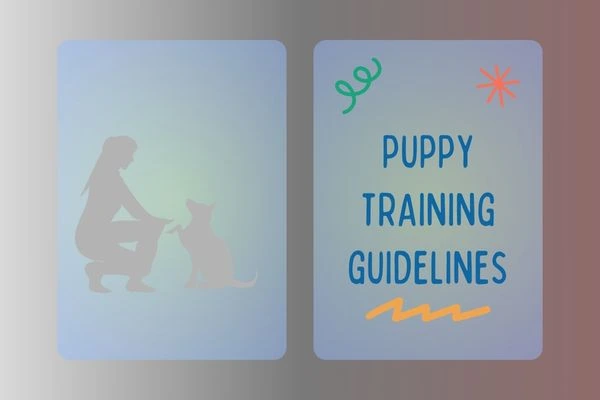A pup that isn’t trained is the worst nightmare for the owner.
Young minds are impressionable.
It applies to dogs, cats, and other pets as well.
Therefore, training dogs as soon as possible is of utmost importance.
Don’t know where to start though?
Fret not!!
We have you covered.
We bring to you a list of guidelines spread across various categories to keep you prepared.
When to Start Training a Puppy?
Puppy training should start as early as 8 weeks old, which is typically when puppies are weaned and ready to join their new homes. At this stage, they are already capable of learning basic commands, house training, and socialization skills.
-
8-12 Weeks Old: Start with basic commands (sit, stay, come), name recognition, crate training, and potty training.
-
3-4 Months Old: Introduce leash training, socialization with people and pets, and behavioral corrections (like biting and jumping).
-
5-6 Months Old: Strengthen obedience skills, work on impulse control, and prevent separation anxiety.
-
6+ Months: Focus on advanced commands, leash manners in busy areas, and reinforcing good behavior in public spaces.
Starting early prevents bad habits from forming and helps your puppy develop confidence and trust in you. Even older puppies and rescue dogs can be trained, but the earlier you start, the easier it will be!
5 Essential Puppy Training Tips
Training your puppy takes patience, consistency, and positive reinforcement. Here are the top 5 tips to make training effective and enjoyable:
1. Use Positive Reinforcement
-
Always reward good behavior with treats, praise, or toys.
-
Avoid punishment, as it can cause fear and anxiety in your puppy.
-
Reward immediately after your puppy follows a command so they associate the action with the reward.
2. Keep Training Sessions Short & Fun
-
Puppies have short attention spans, so 5-10 minute sessions work best.
-
Train 2-3 times a day instead of one long session.
-
End each session on a positive note with a reward to keep them excited for the next session.
3. Be Consistent with Commands
-
Use the same words for commands (e.g., “Sit” instead of “Sit down”).
-
Everyone in the household should use the same commands and rules.
-
Consistency helps puppies learn faster and prevents confusion.
4. Train in a Distraction-Free Environment First
-
Start training in a quiet room with no distractions.
-
Once your puppy masters a command, practice it in new environments (yard, park, around other dogs).
-
Gradually increase distractions to improve their focus and obedience.
5. Prevent Bad Habits Early
-
Puppies will test boundaries, so correct unwanted behaviors immediately.
-
If your puppy jumps on people, turn away and ignore them until they sit.
-
If they chew on furniture, redirect them to an appropriate chew toy.
See Also:
- 120+ Dog Names inspired by Movies (Disney, Hollywood)
- 71+ Outdoor Activities for Dogs to keep them Active
- 10+ Best Dog Toys to Buy if you Love your Doggo
5 Step-by-Step Methods to Train Your Puppy at Home
Here’s a simple step-by-step guide on how to train your puppy effectively at home.
1️⃣Teaching “Sit” (The First Command Every Puppy Should Learn!)
Why? It helps control jumping, hyperactivity, and leash manners.
How to Teach:
-
Hold a treat close to your puppy’s nose.
-
Slowly move the treat upward so their bottom naturally lowers into a sitting position.
-
The moment they sit, say “Sit”, then reward them with the treat and praise.
-
Repeat 4-5 times a day for short sessions.
2️⃣ Potty Training (House Training Made Easy!)
Why? Prevents accidents and establishes a reliable routine.
How to Train:
-
Take your puppy outside first thing in the morning, after meals, after naps, and before bedtime.
-
Always use the same potty spot to help them associate the area with elimination.
-
When they potty in the right spot, praise them and give a treat immediately.
-
If accidents happen inside, clean it with an enzyme cleaner to remove odor and prevent re-marking.
3️⃣ Leash Training (Walks Without Pulling!)
Why? Ensures safe, enjoyable walks and good leash manners.
How to Train:
-
Let your puppy wear the leash indoors first to get used to it.
-
Start with short walks in a low-distraction area.
-
If they pull, stop walking immediately until they return to your side.
-
Reward calm walking behavior with treats or praise.
4️⃣ “Come” Command (Reliable Recall Training!)
Why? Keeps your puppy safe from danger and improves off-leash control.
How to Train:
-
Use a happy, excited tone and say “Come” while holding a treat.
-
When your puppy comes to you, reward immediately with praise and treats.
-
Start in a quiet space, then practice in different environments with more distractions.
-
Never punish your puppy if they don’t come right away—make it fun so they always want to run to you!
5️⃣ Stopping Nipping & Biting (Gentle Mouth Training!)
Why? Prevents painful biting, aggressive play, and bad habits.
How to Train:
-
If your puppy bites during play, say “Ouch!” in a high-pitched voice and stop playing immediately.
-
Offer a chew toy instead and praise them when they chew the right item.
-
If biting continues, ignore them for 10-15 seconds to show that rough play ends the fun.
-
Be consistent—puppies learn through repetition!
To have a pet is one thing.
But to have a well trained and disciplined one is like a cherry on top.
So, to make it happen we bring to you a list of guidelines that’ll help you train your canid.

Nikita Rout is a passionate content writer at HowItSee.com, where she explores the wonders of animals, nature, and the curious questions that spark our imagination. With a love for research and a knack for simplifying complex topics, she brings clarity and creativity to every article she writes. When she’s not writing, you’ll likely find her reading about animal behavior or coming up with unique pet name ideas.

